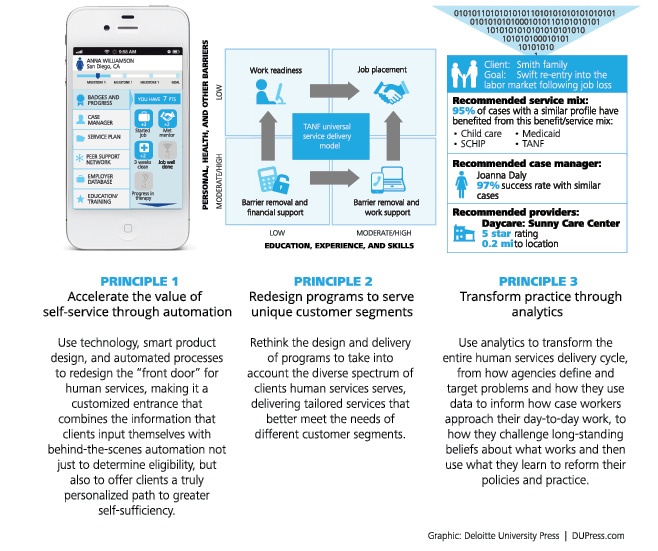Rethinking public sector delivery

 Dr Danny McConnell, technology partner at Deloitte in Belfast, explores the life changing opportunities ahead for public services as they adopt a transformational approach to outcomes.
Dr Danny McConnell, technology partner at Deloitte in Belfast, explores the life changing opportunities ahead for public services as they adopt a transformational approach to outcomes.
The draft Programme for Government framework (PfG) is a new approach which focuses on the major societal outcomes that the Northern Ireland Executive wants to achieve over the period 2016-21. One of the key elements of the approach is a focus on outcomes, which aims to move public services from transactional to transformational.
The implementation of the PfG approach will be challenging, however, a recent Deloitte University Press publication, Rethinking human services delivery, identifies a potential framework which involves adopting the three principles illustrated in Figure 1.
The Deloitte research notes that, for most public service programmes the business day consists of programmed actions and reactions, inputs and outputs, moving back and forth among government workers, their data systems and their customers. Success is defined primarily by the timeliness and accuracy of these transactions rather than their results. This has led to a model in which outcomes are, in fact, merely outputs.
However, such measures do not necessarily translate into meaningful outcomes for real people. As noted in the research, what is often missing is any consideration of the extent to which these quantitative transactions have anything to do with qualitative changes in people’s lives. For example, if an agency responds to 98 per cent of its child-abuse hotline calls within 24 hours, what about the 2 per cent the agency didn’t get to – were those children safe?
This is not to say that output measures are not important, they are, and public sector organisations should continue to track them. There will always be a requirement for the accurate delivery of public sector services. However, transactional measures alone cannot support the kind of outcomes envisaged in the PfG.
It is easy to become fixated on transactional measures because they are exactly the requirements for which public sector organisations are likely to be held publicly accountable. As a result, the people who work in internal data reporting are driven largely by the capture and reporting of performance indicators that may have little or no relation to real-world results for citizens. In this environment, it is entirely possible for a public sector organisation to meet or exceed transactional performance metrics while experiencing breakdowns in the system.
This pattern is beginning to change, thanks to the proliferation of new technologies and methods, and the introduction of more sophisticated data analytics.
While public sector organisations have always collected, stored and reported a glut of data, the information was rarely readily available for problem-solving or managing day-to-day work. This ability to turn volumes of data into actionable insights opens up new possibilities for redefining public services.
Principle 1: Accelerate the value of self-service through automation
Frontline public sector employees are the people best placed to improve the trajectory of customers’ lives. Too often, however, they are shackled by paperwork and kept from the hands-on work that actually transforms lives.
Thanks to technological developments we can change this pattern by working to eliminate the paperwork burden and provide case management that is intensive, specialised and reserved for the clients who need it.
Public services agencies should ask themselves how they can use technology, smart product design, and automated processes to redesign their front door, making it a customised entrance that combines the information the clients input themselves with behind-the-scenes automation, not just to offer clients a personalised path to greater self-sufficiency, but one that clients can self-navigate and manage on their own behalf. At a local level, digital transformation across the public sector is being driven through the NI Direct programme, which will provide customers with a range of online services.
Principle 2: Redesign programmes to serve unique customer segments
Emergency department doctors recognised this priority a long time ago. The triage protocol is designed to assess patients based on the severity of their immediate conditions and treat them accordingly.
Public sector organisations tend to do things differently. Rather than probing the circumstances that bring individuals or families into contact, and targeting the problems that must be solved, the focus is on identifying which programmes the individual or family are eligible for, irrespective of whether these programmes align with the reason they came into contact.
This culture of eligibility pervades public services, offering packages of services and benefits that may excessively treat or entirely miss the problems that bring the customers into contact in the first place. The challenge then, is to understand which goals are best for which individual or family, and to provide them with the services and benefits most likely to help achieve them.
In the private sector, businesses do this by breaking their larger customer population into sub-groups with similar characteristics. By doing so, it allows the organisation to tailor their services to the unique needs of each customer segment more effectively and efficiently. A one-size-fits-all model is poorly suited for the diverse needs of public service customers.
Principle 3: Transform practice through analytics
Due to advancements in technology, enhanced data capture, increased use of advanced analytics, and a shift in focus from “hindsight” indicators to predictive factors, public services providers can glean new insights from transactional data and use them to fundamentally transform the relationships between staff and their tasks, between staff and their customers, and between customers and the services they receive.
Analytics holds the potential for transforming the entire public services delivery cycle. From how public services organisations define and target problems, to how they use data to inform how staff approach their day-to-day work, to how to challenge long-standing beliefs about what works and then use what they learn to reform their policies and practices.
So, what does this mean from a Northern Ireland context?
In the past, when public sector executives wanted to drive change they typically changed the people doing the work or the policies driving the work. Changing their business processes was often the last thing considered and for good reason. In government, the business model is hardwired into and driven by the organisation’s technology and data systems. Public sector leaders need business models that leverage and integrate the data they have, that are adaptable to rapidly changing technologies, and that use data extraction and analysis to improve frontline practices. Thanks to advances in technology and analytical techniques, public sector organisations are now poised to move beyond transactional service delivery, which will necessitate a joined up approach to data and service delivery.
When public sector organisations can put their data in front of the people, both customers and staff, who need it, in a way they can readily comprehend, and in time to use the data in a way that affects results, then what was once a transactional business model can become a transformational business one, capable of achieving potentially life-changing outcome in an efficient and cost-effective way.
Dr Danny McConnell
Technology Partner, Deloitte
Email: dcconnell@deloitte.co.uk
Tel: 028 9053 1169






